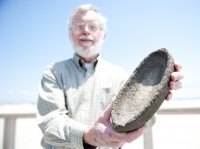Navy archaeologist have discovered a rare Native American boat effigy on San Clemente Island (SCI). SCI, one of Southern California’s Channel Islands 90 miles west of San Diego, is owned by the US Navy which uses it as ship-to-shore live firing range. The island also has thousands of archaeological sites dotting its 57 square miles. As part of its legally mandated stewardship of the land, the Navy employs archaeologists to survey and excavate these sites. They’ve already identified 4,000 archaeological sites on the 55% of the island that has already been surveyed; experts estimate there are at least that many again yet to be found. Artifacts like hooks carved from shellfish, stone knives, carved animal, drills and bone needles have been discovered that are up to 10,000 years old.
This exceptional archaeological wealth is due to its lack of permanent residents for many centuries and an ecological quirk: the island is completely devoid of burrowing rodents or worms. Archaeologists don’t even have to dig to find artifacts from the pre-Columbian inhabitants. They sit on the surface, where they’ve sat undisturbed for thousands of years. That’s where archaeologists found the boat effigy, in fact, on the surface of a site they were surveying.
 The stone boat is nine inches long, weighs about three and a half pounds and was carved from submarine volcanic rock. This is a difficult material to sculpt because submarine lava has smaller vesicles than lava on land. All those little pores make the rock as brittle as it is hard. The artist who carved the boat was a highly skilled craftsman paying homage to the canoes that were an essential part of their culture as ocean-dependent people. These canoes were crafted from redwood logs carried by floods down the coast. They were cut into planks which were then sewn together with plant ropes. The gaps were caulked with natural tar.
The stone boat is nine inches long, weighs about three and a half pounds and was carved from submarine volcanic rock. This is a difficult material to sculpt because submarine lava has smaller vesicles than lava on land. All those little pores make the rock as brittle as it is hard. The artist who carved the boat was a highly skilled craftsman paying homage to the canoes that were an essential part of their culture as ocean-dependent people. These canoes were crafted from redwood logs carried by floods down the coast. They were cut into planks which were then sewn together with plant ropes. The gaps were caulked with natural tar.
As important as the canoes were for transportation to the mainland, trading and fishing, boat effigies are not at all common finds amidst the plethora of artifacts on the island.
“In 30 years, it’s the first time I’ve found one. Even for a reasonably jaded archeologist, this was a reasonably rare find,” Andy Yatsko, the Navy’s archaeologist for San Clemente Island, said during an outing on the island this week. […]
Yatsko said it likely dates back 500 to 1,000 years — a relatively recent artifact for the island, which was inhabited for at least nine millennia.
Dr. Yatsko has seen references to boat carvings in old records, but has never seen one in person. Archaeologists from the San Diego Museum of Man excavated the island before the Navy purchased it in 1934 and they never found anything like a boat effigy either. Plenty of carved volcanic rock animals, but no boats.
Researchers aren’t sure which Native American tribes populated the island. The prime candidates are the Tongva people who are known to have inhabited nearby Santa Catalina Island. The Chumash were in the northern Channel Islands and may have interacted with the people on San Clemente, positively or negatively. Skeletons have been found piled on top of each other on SCI which suggests hostile encounters, even wars, took place on the island.